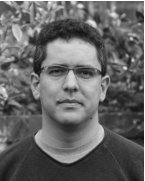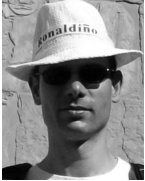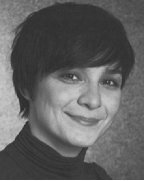
© Third Infinity 2015









THIRD
INFINITY
2015

14th - 16th October 2015 in Göttingen, Germany
2nd Conference on Physics of
Biological and Complex Systems
Presenting Third Infinity 2015, a conference organized by the doctoral
candidates of the International Max Planck Research School - Physics of
Biological and Complex Systems (IMPRS-PBCS). This conference aims to bring
together young researchers and leading scientists working on complex systems
from the three fundamental perspectives: theory, experiments and simulations.

Palash Bharadwaj
Photonics Laboratory, ETH Zürich Antenna-coupled photoemission from single emitters and single electrons Optical antennas are devices that convert energy efficiently between propagating and localized radiation. In this talk, I will introduce the concept of optical antennas, and review my work in antenna- enhanced optical interactions within the context of nanoscale microscopy and spectroscopy. I will highlight the high spatial localization and fluorescence enhancement that plasmonic optical antennas bring about when coupled to single quantum emitters. I will further show that inelastically tunneling electrons can excite localized and propagating plasmons in optical antenna structures ithout the need of any external radiation, thus opening up new opportunities for truly nanoscale ultrafast optoelectronic signal transduction. Finally, I will cover some of my most recent work on antenna- coupled photoemission from novel 2D semiconductors like MoS2.
Katharina Anna Zweig
Network Analysis and Graph Theory, TU Kaiserslautern Algorithm Literacy - what YOU need to know about algorithms Almost everyone of us is dependent of the work of algorithms - be it in our private or academic lifes. How much can you rely on them? Can you use this very interesting software package you found on the web and that says it does exactly the thing you want it to do? Did the computer scientist in your team choose the best method to analyze your data? Or are you a computer scientist that needs to understand this Biologese/Medicalese/OtherScience-lese to finally understand what he or she actually wants to know about the data? Algorithm literacy gives you an insight in how we today talk about the results of algorithms and why this is dangerous in interdisciplinary academic teams. Additionally, our communication culture regarding algorithms also has huge implications on our life as citizens. The talk will thus animate you to become more literate in choosing the algorithms that influence your life.
Fernando Perez
Data Science and Technology Division, Lawrence Berkeley National Laboratory Data Science: mere buzzword, or a lasting transformation of science? The rise of data-intensive research across all scientific domains has shaken our scientific practices, forced us to reinvent many of the tools of our research, and led to a number of extraordinary discoveries. But it also poses questions about the nature of science itself: do we still need models? What is the role of first-principles, ab-initio thinking in a world awash in noisy data? And furthermore, as the term "data science" is adopted by society to mean things like ad analytics, what is the role of our research mission in this context? I will try to explore some of these questions, from the perspective of the tools, projects and institutions that I have been involved with building over the last 15 years.
Mihaela Delcea
ZIK HIKE, University of Greifswald Cell mechanics in disease diagnosis Cell dynamics (e.g. circulation of blood cells through tiny capillaries, contractility of cardiac cells) is highly determined by cell mechanics. Cells have been shown to adapt and change their elasticity in response to drugs, antibodies, shear stress, etc. Using colloidal probe atomic force microscopy, we have investigated the mechanics of single cells involved in various diseases by quantifying their Young’s modulus. We have demonstrated that cardiac fibroblasts (CFBs) isolated from the left ventricular biopsies of patients with dilative cardiomyopathy showed significantly decreased stiffness when compared with CFBs from the right ventricle. This decrease in stiffness could trigger ventricular dilation in patients with recent-onset cardiomyopathy. As a platform to study cardiac diseases, I will refer to the potential use of highly ordered arrays of 3D micropillars as a platform to analyse the mechanobiology of human induced pluripotent stem cell-derived cardiomyocytes (iPSC-CM) describing their impact on the subcellular reorganization of sarcomeres and biochemical changes mediating calcium signaling. In the pathogenesis of transfusion-related acute lung injury (TRALI) - a severe adverse effect of blood transfusion, neutrophil passage through the pulmonary microvasculature is a critical step. We have shown that HNA-3a antibodies induce neutrophil stiffening which may result in neutrophil retention in the microvasculature. In addition, I will discuss the use of our developed model (based on the simple Hertz model and the Johnson–Kendall–Roberts (JKR) model) for the analysis of AFM force-distance curves measured on soft spherical cell-like particles. This model considers two independent particle deformation sites: (i) the upper part of the particle is deformed by the AFM indenter, (ii) the bottom part is deformed by the substrate.
Dirk Brockmann
Institute for Theoretical Biology, Humboldt University Berlin Behavior, Disease & Information: Can we do experiments in epidemiology? Unlike physics, epidemiology is a science that has to cope with the absence of controlled experiments. As a consequence it is difficult to identify key factors that shape disease dynamics and test the predictions of mathematical or computational models in the field. Although we understand the basic mechanisms how human behavior, e.g. mobility and inter-individual contact patterns impact disease dynamics on a population level, even the most sophisticated models cannot capture the impact that information about the prevalence of a disease has on behavior and how these changes feed back on disease dynamics. I will discuss results from a recent project in which we performed controlled epidemic experiments in a population of 1000 students in a large scale vaccination game in which a virtual disease spreads via Bluetooth face-to-face contacts and in which information on the disease changed the perceived risk of infection and vaccination. Because of the experimental setup we were able to investigate entire transmission trees and assess the impact of information on behavioral modalities on an individual level. As predicted by a previous theoretical study, we show that an intermediate amount of information available to individuals induces optimal disease mitigation.
Helena Knowles
Quantum Information and Nanoscale Metrology Group, University of Cambridge Spins in Diamond for Nanoscale MRI The detection of weak magnetic fields created by electron or nuclear spins enables the non-invasive probing of solid state and soft systems and is already ubiquitous in medical imaging and structural biology. However, research efforts ranging from biology to material science are increasingly in need of a magnetic field probe with nanoscale resolution. For instance, the regulation of ion transport through ion channels in cell membranes, the imaging of a single molecule or the mechanisms of spin ordering in graphene nanoribbons and other advanced materials are key, topical processes under investigation. Recently, a particularly promising platform for magnetic field sensing has emerged in the form of nitrogen-vacancy centres (NVs). NVs in diamond are naturally occurring point defects that form a highly localised quantum state sensitive to magnetic fields. The quantum state spin is stable and controllable at room temperature making it an excellent candidate for performing nanoscale magnetometry in a wide range of environments and under ambient conditions. I will provide an overview of NV-based sensing with a special emphasis on NVs in diamond nanocrystals. The nanocrystal host provides an interesting and complex environment for the optically active NV spin. Its interactions with a cluster of other electronic spins associated with impurity atoms in the diamond can act as a source of decoherence but, if manipulated correctly using radiowave pulses, this cluster could also become a resource and enable enhanced imaging. I will present our latest measurements on the polarisation and control of such a dark spin cluster.
Greg Fuchs
School of Applied & Engineering Physics, Cornell University Coherent control over diamond nitrogen-vacancy center spins with a mechanical resonator Creating coherent interactions between disparate quantum systems represents both a challenge and an opportunity. Although it is experimentally difficult to coherently couple different quantum systems together, efforts to create “hybrid quantum systems” are appealing because they potentially offer opportunities to combine the best parts of each component for a particular task. This is important both for future quantum information processing and for sensor technology that is enhanced by quantum coherence. The growing realization that mechanical resonators can be coupled to a wide range of different physical quantum states has motivated intense research into the coherent interactions between mechanical degrees of freedom and physical qubits. Here I will describe our experiments to coherently couple diamond nitrogen-vacancy (NV) center spins to high-frequency mechanical resonators through intrinsic lattice strain. We show that it is possible to directly drive resonant spin transitions without mediation by a magnetic driving field [1]. In diamond mechanical resonators with fQ = 2×10^12, gigahertz frequency strain waves drive up to 3.8 MHz Rabi oscillations on a magnetically forbidden spin transition [2]. This capability is a new resource for quantum control of NV center spins because it provides access to all transitions within the NV center’s spin-1 manifold. To demonstrate the benefit of this unique control, we use the mechanical resonator to “dress” the NV spin eigenstates, creating a spin basis that is protected from the decohering magnetic fluctuations of spin impurities within the environment [3]. These coherent and direct interactions between spins and phonons represent first steps in a path that leads to a hybrid spin-phonon realization of cavity quantum electrodynamics. [1] E. R. MacQuarrie, T. A. Gosavi, N. R. Jungwirth, S. A. Bhave, and G. D. Fuchs, Phys. Rev. Lett. 111, 227602 (2013). [2] E. R. MacQuarrie, T. A. Gosavi, A. M. Moehle, N. R. Jungwirth, S. A. Bhave, and G. D. Fuchs, Optica 2, 233 (2015). [3] E. R. MacQuarrie, T. A. Gosavi, S. A. Bhave, and G. D. Fuchs, in preparation (2015).
Abhinav Sharma
Department of Physics and Astronomy, VU University Strain-controlled criticality governs the nonlinear mechanics of fibre networks Disordered fibrous networks are ubiquitous in nature as major structural components of living cells and tissues. The mechanical stability of networks generally depends on the degree of connectivity: only when the average number of connections between nodes exceeds the isostatic threshold are networks stable. Upon increasing the connectivity through this point, such networks undergo a mechanical phase transition from a floppy to a rigid phase. However, even sub-isostatic networks become rigid when subjected to sufficiently large deformations. To study this strain-controlled transition, we perform a combination of computational modeling of fibre networks and experiments on networks of type I collagen fibers, which are crucial for the integrity of biological tissues. We show theoretically that the development of rigidity is characterized by a strain-controlled continuous phase transition with signatures of criticality. Our experiments demonstrate mechanical properties consistent with our model, including the predicted critical exponents. We show that the nonlinear mechanics of collagen networks can be quantitatively captured by the predictions of scaling theory for the strain-controlled critical behavior over a wide range of network concentrations and strains up to failure of the material.
Tobias Galla
Complex Systems and Statistical Physics Group, The University of Manchester You are a young and aspiring physicist. Is working at the interface with economics or biology a good idea? The terms econophysics and sociophysics describe research in which physicists apply their ideas and methods to problems in economics and the social sciences. What do you have to know about the field to answer the question in the title? Similarly, what are the opportunities and dangers of working at the interface with the biological sciences? ln this talk I will give you my personal assessment of what physicists can contribute to the field of economics, to biology and more generally to the science of complexity. I will discuss the main achievements of physicists. At the same time you will hear about the things physicists have not achieved (despite occasional claims to the contrary). I will then present some of our own work on chaotic dynamics in the learning of complicated games and on modelling of evolutionary processes in the initiation of cancer. In the final part of the talk I will comment on the potential hurdles young physicists moving into this area might want to be aware of, and I will highlight the potentials and benefits of working in an interdisciplinary setting.
Jan Nagler
Computational and Theoretical Physics Group, Institute for Building Materials, ETH Zürich Anomalous critical and supercritical phenomena in explosive percolation The emergence of large-scale connectivity on an underlying network or lattice, the so-called percolation transition, has a profound impact on the system’s macroscopic behaviours. There is thus great interest in controlling the location of the percolation transition to either enhance or delay its onset and, more generally, in understanding the consequences of such control interventions. Here we review explosive percolation, the sudden emergence of large-scale connectivity that results from repeated, small interventions designed to delay the percolation transition. These transitions exhibit drastic, unanticipated and exciting consequences in complex networked systems.
Isabella Guido
Chemotaxis and Actin-Based Motility Group, Max Planck Institute for Dynamics and Self-Organization Effects of DC electric fields on the directional migration of Dd cells Exogenous and endogenous electric fields play a role in cell physiology as a guiding mechanism for the orientation and migration of cells. Electrotaxis of living cells has been observed for several cell types, e.g. neurons, fibroblasts, leukocytes, neural crest cells, cancer cells. Dictyostelium discoideum (Dd), an intensively investigated chemotactic model organism, also exhibits a strong electrotactic behavior moving toward the cathode under the influence of electric fields. Here we report experiments on the effects of DC electric fields on the directional migration of Dd cells. We apply the electric field to cells seeded into microfluidic devices equipped with agar bridges to avoid any harmful effects of the electric field on the cells (ions formation, pH changes, etc.) and a constant flow to prevent the build-up of chemical gradient that elicits chemotaxis. Our results show that the cells linearly increase their speed over time when a constant electric field is applied for a prolonged duration (2 hours). This novel phenomenon cannot be attributed to mechanotaxis as the drag force of the electroosmotic flow is too small to produce shear forces that can reorient cells. It is independent of the cellular developmental stage and to our knowledge, it was not observed in chemotaxis.
Val Zwiller
Quantum Transport Group, Kavli Institute of Nanoscience Delft Quantum optics with nanowires Nanoscale devices offer new opportunities for quantum optics; in particular nanowires offer exciting opportunities to generate, manipulate and detect light at the single photon level. The new tools we are developing allow us to play with fundamental physics, such as quantum entanglement and also enable us to develop new technologies such as single photon detectors with a wide range of applications. A quantum LED for instance enables to conversion of single electrons into single photons and several schemes have been explored to generate entangled pairs of photons with a single nanostructure. I will cover both aspects: fundamental science with nanoscale emitters and applications that we have brought to the commercial stage with superconducting nanowires for single photon detection.
Giovanni Volpe
Soft Matter Lab, Bilkent University Behavior and applications of active Brownian particles in complex and crowded environments Active matter systems – e.g., colonies of microscopic particles capable of self-propulsion – are able of driving themselves into a far-from-equilibrium state by taking up energy from their environment. Because of this property, they can explore novel forms of organization that are not attainable by matter at thermal equilibrium – e.g., groups of passive Brownian particles. Such novel forms of organization include, for example, self-assembly, swarming and the emergence of other collective properties. I will review the significant and growing effort that has been devoted in recent years to advance this field and to explore its applications to a diverse set of disciplines such as statistical physics, biology, robotics, social transport, soft matter and biomedicine.
Elisa de Ranieri
Nature Energy, Nature Publishing Group Publishing and science communication Publishing research in scientific outlets is an important aspect of science communication. Nature- branded journals strive to publish papers that report significant advances in research areas within their respective scopes. Manuscripts are handled by in-house, professional editors who are responsible for conducting a rigorous and fair peer-review process and for each decision up to acceptance of the work for publication. Beside original research articles, Nature journals publish also review and commentary articles authored by experts in the field. I will provide insight into the editorial process at Nature journals, to help authors in the preparation of their manuscript for submission and to clarify how the valuable input of referees enters the editorial decision. In particular, I will discuss the editorial criteria for the different journals within the Nature family, and how the external peer review is handled up to publication. Other channels for communicating science are equally important. Ultimately, science should benefit the wider society, and participation of the general public and policy makers is key. A different register is needed for these channels, and scientists should be capable and willing to engage with the public, to make sure they understand science issues and appreciate their significance. Finally, the importance of developing soft skills - such as people and networking skills, communication skills, focus and perseverance, self-confidence, and persuasion – for a successful academic career is normally understated in PhD programmes, and young researchers should recognise the importance of such skills and dedicate effort to developing them. I aim to provide a few tips on how to hone these skills in an academic setting. These are tips that I wish someone had shared with me back when I was a student.








